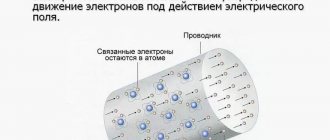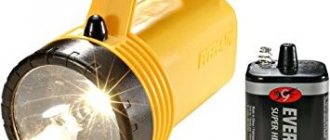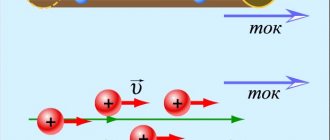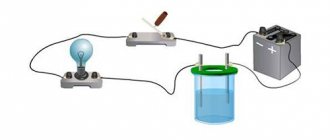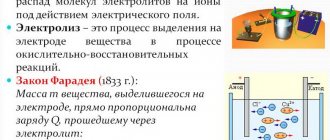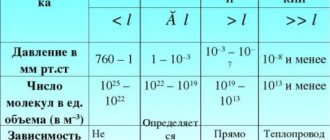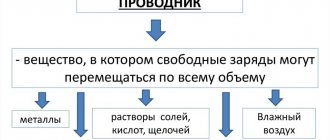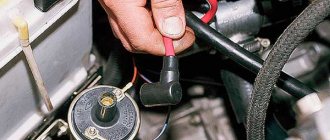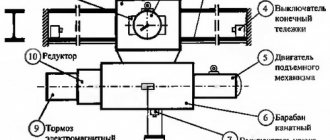High frequency currents
- alternating current (starting from a frequency of approximately tens of kHz), for which phenomena such as the radiation of electromagnetic waves and the skin effect become significant. In addition, if the dimensions of the elements of an electrical circuit become comparable to the wavelength of alternating current, then the principle of quasi-stationary state is violated [1], which requires special approaches to the calculation and design of such circuits.
| This section is not completed. You will help the project by correcting and expanding it. |
Receipt
To obtain currents with a frequency of up to several tens of kilohertz, electric machine generators are used, consisting of two main parts: a rotor and a stator. Their surfaces facing each other have teeth, the mutual movement of which causes a pulsation of the magnetic field. The frequency of the current obtained in this way is equal to the product of the number of rotor teeth and the frequency of its rotation. Until the 1950s, electrical machine radio transmitters were used in radio broadcasting and radio communications (see Grimeton radio station).
A more common method of producing HDTV is the use of oscillatory circuits. This can be an electrical circuit containing capacitance and inductance. (See Signal Generator).
To obtain centimeter and millimeter waves (that is, current with a frequency of billions of hertz), devices with a volumetric resonator (klystron, magnetron, TWT, BWO) are used. An electrode is placed in an airless space near the hot cathode, in which one or more cavities are made, into which a flow of electrons is directed. With the correct selection of the electric field voltage, direction and power of the electron flow, it is grouped into separate bunches. The length of the electromagnetic wave received in the cavity of the resonator is approximately equal to twice the length of this cavity.[2]
High frequency currents in technology
Oscillations and waves
| Wave process. |
Dip the stick into the pond. The water level should rise. But this increase is so insignificant that it is difficult to detect. And if you alternately immerse a stick in the water and pull it out, then waves will run through the water. They are noticeable at a considerable distance from the place of origin. This mechanical movement of water can be compared to electromagnetic phenomena. A constant electromagnetic field appears around a conductor carrying direct current. It is difficult to detect it far from a current-carrying conductor.
But if an alternating electric current is passed through a conductor, then the electromagnetic forces around the conductor will change all the time, that is, the electromagnetic field around it will ripple. Electromagnetic waves travel from a conductor carrying alternating current.
The distance between the two closest wave crests on a pond is the wavelength. It is denoted by the Greek letter λ
(lambda).
The time during which any section of the wavy surface of the water rises, falls and again returns to its initial position is the period of oscillation
-
T. The reciprocal quantity is called the oscillation frequency and is denoted by the letter f
. Oscillation frequency is measured in cycles per second. The unit of measurement of oscillation frequency, corresponding to one period per second, is named hertz (Hz) - in honor of Heinrich Rudolf Hertz (1857 - 1894), the famous researcher of oscillations and waves (1 thousand hertz = 1 kilohertz, 1 million hertz = 1 megahertz) .
Wave speed ( s
) is the distance over which the waves travel in one second. During one period T, the wave motion manages to spread exactly to the length of one wave X. The following relations are valid for wave motion:
c • T = λ; c/f = λ
These relationships between oscillation frequency, wavelength and wave speed are true not only for water waves, but also for any oscillations and waves.
It is necessary to immediately emphasize one property of electromagnetic oscillations. When they propagate in empty space, then whatever their frequency, whatever the wavelength, their speed of propagation is always the same - 300 thousand km/sec. Visible light is a type of electromagnetic vibration (with a wavelength from 0.4 to 0.7 millimicrons and a frequency of 1014 - 1015 Hz). The speed of propagation of electromagnetic waves is the speed of light (3•1010 cm/sec).
In air and other gases, the speed of propagation of electromagnetic oscillations is only slightly less than in emptiness. And in various liquid and solid media it can be several times less than in emptiness; in addition, here it depends on the oscillation frequency.
| The smallest and the largest There are many units of measurement of energy: erg, joule, calorie, etc. The smallest of them is the electronvolt: an electron accelerated in an electric field between points with a potential difference of 1 V will have an energy of 1 electronvolt. The largest unit of energy was recently proposed by the Indian scientist Homi Baba to calculate the world's energy reserves. Its unit is equal to the thermal energy that is released when burning 33 billion tons of coal. The scientist took this amount of coal because over the past 20 years, during which a particularly large amount of coal was mined and burned, exactly 33 billion tons of coal was extracted from the bowels of the earth. |
Radiation and emitters
We live in a world of electromagnetic vibrations. Sunlight, the mysterious streams of cosmic rays falling on Earth from interstellar space, the heat emitted by a hot stove, and the electric current circulating in power networks are all electromagnetic oscillations. They all propagate in the form of waves, in the form of rays.
Every object, every body that generates waves is called a radiator. The stick that is dangled in the pond is an emitter of water waves. Water resists its movement. To move a stick, you need to expend power. This power transmitted to the water is numerically equal to the product of the square of the speed of movement of the stick and the resistance to movement. Part of this power is converted into heat - it is used to heat the water, and part of it is used to create waves.
| When the oar moves in water, the resistance of heat generation and the resistance of radiation (wave formation) are overcome. |
It can be said that the total resistance experienced by a stick is the sum of two resistances: one of them is the resistance of heat generation, and the other is the resistance of wave formation - the radiation resistance, as it is commonly called.
The same patterns apply to electromagnetic phenomena. The power consumed by electric current in a conductor is equal to the product of the resistance of the conductor and the square of the current in it. If we take the current in amperes and the resistance in ohms, then the power will be in watts.
In the electrical resistance of any conductor (as in the mechanical resistance of water to the movement of a stick), two components can be distinguished: heat generation resistance - ohmic resistance and radiation resistance - resistance caused by the formation of electromagnetic waves around the conductor, carrying away energy.
Take, for example, an electric hot plate for which the ohmic resistance is 20 ohms and the current is 5 A. The power converted into heat in this tile will be 500 W (0.5 kW). To calculate the power of the waves traveling from the emitter, you need to multiply the square of the current in the conductor by the radiation resistance of this conductor.
Radiation resistance is complexly dependent on the shape of the conductor, its size, and the length of the emitted electromagnetic wave. But for a single straight conductor, at all points of which the current flows in the same direction and the same strength, the radiation resistance (in ohms) is expressed by a relatively simple formula:
Rizl=3200(l/λ)2
Here l
is the length of the conductor, and
λ
is the length of the electromagnetic wave (this formula is valid for
l
significantly smaller than
λ
).
For rough estimates, this formula can be used for any electrical structures, any machines and devices, for example, for a heating tile, in which the wire is not straight, but is rolled into a spiral laid in a zigzag. But as l
In the formula for radiation resistance, it is necessary to substitute not the full length of the conductor, but one of the given dimensions of the structure in question.
For a heating tile , l
is approximately equal to the diameter of the tile.
| Transferring a push along a line of dominoes. Energy is also transferred from particle to particle during mechanical wave motion. |
Central power plants produce alternating current with a frequency of 50 Hz. This current corresponds to an electromagnetic wave 6 thousand km long. Not only electric stoves, but also the largest electrical machines and apparatus and even long-distance power lines have dimensions l
many times smaller than the length of this electromagnetic wave. The radiation resistance of the largest electrical machines and devices for current with a frequency of 50 Hz is measured in insignificant fractions of an ohm. Even with currents of thousands of amperes, powers of less than one watt are emitted.
Therefore, in practice, when using industrial current with a frequency of 50 Hz, it is not necessary to take into account its wave properties. The energy of this current is tightly “tied” to the wires. To connect a consumer (lamps, stoves, motors, etc.), direct contact with current-carrying wires is necessary.
As the frequency of the current increases, the length of the electromagnetic wave decreases. For example, for a current with a frequency of 50 MHz it is equal to 3 m. With such a wave, even a small conductor can have significant radiation resistance and, at relatively small currents, emit significant amounts of energy.
According to refined calculations, a conductor half a wavelength long (l=λ/2)
has a radiation resistance
Riz.
about 73 ohms. At a current of, say, 10 A, the emitted power will be 7.3 kW. A conductor capable of emitting electromagnetic energy is called an antenna. This term was borrowed by electricians at the end of the last century from entomology - the antenna is the antennae-tentacle of insects.
At the origins of radio engineering
Electromagnetic oscillations occurring at a frequency of a million billion hertz are perceived by our vision as light. Vibrations that are a thousand times slower can be felt by the skin as heat rays.
Electromagnetic vibrations, whose frequency ranges from a few kilohertz to thousands of megahertz, are not perceived by the senses, but they are of great importance in our lives. These vibrations are capable of propagating, like light and heat, in the form of rays. The Latin word for ray is radius. The word “radio waves” is derived from this root. These are oscillations generated by high frequency currents. Their main and most important application is wireless telegraph and telephone communications. For the first time in the world, the wireless transmission of signals by radio waves was practically carried out by the Russian scientist Alexander Stepanovich Popov. On May 7 (April 25), 1895, at a meeting of the physics department of the Russian Physical-Chemical Society, he demonstrated the reception of radio waves.
Nowadays, using radio, you can establish wireless communication between any point on the globe. New branches of high-frequency technology emerged - radar, television. Radio engineering began to be used in various industries.
It is right to begin a review of high-frequency technology with methods for producing high-frequency alternating currents.
The oldest and simplest way to produce high-frequency electromagnetic oscillations is to discharge a capacitor through a spark. The first radio transmitters of A. S. Popov had spark generators with such simple spark gaps in the form of two balls separated by an air gap.
| Machine generator of high frequency current. |
At the beginning of this century, improved spark gaps appeared, which produced high-frequency oscillations with a power of up to 100 kW. But there were great losses of energy. Currently, there are more advanced sources of high frequency currents (HFC).
To obtain currents with a frequency of up to several kilohertz, machine generators are usually used. Such a generator consists of two main parts - a stationary stator and a rotating rotor. The surfaces of the rotor and stator facing each other are toothed. When the rotor rotates, the mutual movement of these teeth causes a pulsation of the magnetic flux. In the working winding of the generator, laid on the stator, an alternating electromotive force (emf) arises. The frequency of the current is equal to the product of the number of rotor teeth and the number of its revolutions per second. For example, with 50 teeth on the rotor and its rotation speed of 50 rps, a current frequency of 2500 Hz is obtained.
Currently, high-frequency machine generators with a power of up to several hundred kilowatts are produced. They give frequencies from several hundred hertz to 10 kHz.
One of the most common modern methods of producing HDTV is the use of oscillating circuits connected to electrically controlled valves.
Application
High-frequency currents are used in mechanical engineering for heat treatment of the surfaces of parts and welding (see Skin effect), in metallurgy for melting metals, and also for producing electromagnetic waves of the required frequency (radio communications, radar).
Induction heating
Main article: Induction heating
The workpiece is placed inside an installation that, due to the winding, creates an alternating electromagnetic field with a frequency of up to 3 GHz: Wikipedia: Articles without sources (type: not specified)[ source not specified 2268 days
], which, in turn, causes free electrons in metals to move, thereby generating an alternating electric current inside the workpieces; in dielectrics, the electromagnetic field causes the molecules to rotate depending on the magnitude of their dipole moment.
Skin effect
Definition 2
Direct current is distributed evenly across the cross-section of the conductor. With alternating current, due to the inductive interaction of different current elements, the current density is redistributed over the cross section of the conductor. The phenomenon in which the current is predominantly concentrated in the surface layer of the conductor is called skin effect .
Are you an expert in this subject area? We invite you to become the author of the Directory Working Conditions
Let us have a cylindrical conductor through which current flows. A magnetic field is formed around a conductor carrying current. The lines of force of this field are concentric circles, the center of which lies on the axis of the conductor. If the current strength is increased, the magnetic field induction will increase, but the shape of the field lines will not change. Accordingly, the derivative $\frac{\partial \overrightarrow{B}}{\partial t}$ is directed tangentially to the magnetic field induction line, the derivative lines are also circles that coincide with the lines of force. We know from the law of electromagnetic induction that:
The vector of the induction field strength in areas located closer to the axis of the conductor has the direction opposite to the vector of the electric field strength that creates the current; in distant areas the directions of these vectors coincide. As a result, the current density decreases near the axis and increases closer to the surface of the conductor, that is, a skin effect appears.
In metals, due to their high conductivity, the displacement current can be neglected in comparison with the conduction current. Because of this, the penetration of a magnetic field into a metal is similar to the diffusion process in mathematical terms. Let's take equation (1) and equation (2) as a basis:
We use Ohm's law:
Let's equate the right-hand sides of expressions (2) and (3) and differentiate the resulting expression, as a result we have:
Or given formula (1):
We use known relations:
we finally get:
If the current flows through a homogeneous infinite conductor, which occupies the half-space y$>$0 along the X axis, and the surface of the conductor is flat, we can write:
In this case, equation (7) is transformed to the form:
It can be assumed, that:
Substituting expression (11) into equation (10) we obtain:
The solution to equation (12) is the function:
where $\alpha =\sqrt{\frac{\omega \sigma {\mu }_0\mu }{2}}$. Let's take the real part of expression (13) and move on to the current density, using Ohm's law, we get:
If we assume that the current density amplitude $j_0=j_x\left(0,0\right)$, then expression (14) will take the form:
Notes
- [slovar.cc/enc/bse/2003449.html Meaning of QUASI-STATIONARY CURRENT in the Great Soviet Encyclopedia]
- Children's Encyclopedia, volume 5. Academy of Pedagogical Sciences of the RSFSR. Moscow. 1960. p.195
| This article should be Wikified. Please format it according to the article formatting rules. |
| This article or section needs revision. Please improve the article in accordance with the rules for writing articles. |
| This is a draft article about electricity. You can help the project by adding to it. |
High frequency currents and their application.
2018-01-08 2576 Transformer operating modes
· Idling mode. This mode is characterized by an open secondary circuit of the transformer, as a result of which no current flows in it. Using the no-load test, you can determine the transformer efficiency, transformation ratio, and steel losses.
· Load mode. This mode is characterized by a transformer secondary circuit closed to the load. This mode is the main operating mode for the transformer.
· Short circuit mode. This mode is obtained as a result of short-circuiting the secondary circuit. With its help, you can determine the loss of useful power due to heating of wires in the transformer circuit. This is taken into account in the equivalent circuit of a real transformer using active resistance.
28) An oscillating circuit is an oscillator, which is an electrical circuit containing a connected inductor and capacitor. In such a circuit, current and voltage fluctuations can be excited.
Operating principle
Let a capacitor of capacitance C be charged to voltage
. The energy stored in the capacitor is
When a capacitor is connected to an inductor, current will flow in the circuit
, which will cause an electromotive force (EMF) of self-induction in the coil, aimed at reducing the current in the circuit. The current caused by this EMF (in the absence of losses in inductance) at the initial moment will be equal to the discharge current of the capacitor, that is, the resulting current will be zero. The magnetic energy of the coil at this (initial) moment is zero.
Then the resulting current in the circuit will increase, and energy from the capacitor will pass into the coil until the capacitor is completely discharged. At this moment, the electrical energy of the capacitor
. The magnetic energy concentrated in the coil, on the contrary, is maximum and equal to , where is the inductance of the coil and is the maximum current value.
After this, recharging of the capacitor will begin, that is, charging the capacitor with a voltage of a different polarity. Recharging will continue until the magnetic energy of the coil is converted into electrical energy of the capacitor. The capacitor, in this case, will again be charged to voltage
.
As a result, oscillations occur in the circuit, the duration of which will be inversely proportional to the energy losses in the circuit.
In general, the processes described above in a parallel oscillatory circuit are called current resonance, which means that currents flow through the inductance and capacitance, greater than the current passing through the entire circuit, and these currents are greater by a certain number of times, which is called the quality factor. These large currents do not leave the circuit, since they are out of phase and compensate themselves. It is also worth noting that the resistance of a parallel oscillatory circuit at the resonant frequency tends to infinity (in contrast to a series oscillatory circuit, the resistance of which tends to zero at the resonant frequency), and this makes it an indispensable filter.
It is worth noting that in addition to a simple oscillatory circuit, there are also oscillatory circuits of the first, second and third kind, which take into account losses and have other features.
29) Induction alternating current generator - Unlike other generators, the operation of an induction generator is based not on a rotating magnetic field, but on a pulsating one, in other words, the field changes not as a function of displacement, but as a function of time, which ultimately (induction of EMF) gives same result.
The design of induction generators involves the placement of both a constant field and coils for inducing EMF on the stator, while the rotor remains free from windings, but must have a tooth shape, since the entire operation of the generator is based on the tooth harmonics of the rotor.
High frequency currents and their application.
High-frequency currents are currents whose frequency, that is, the number of oscillations, reaches one million per second. This type of current has found its application in mechanical engineering, where it is necessary for welding and heat treatment of the surfaces of parts, and in metallurgy, where it is used for melting various metals.
The use of high frequency currents has brought industries such as mechanical engineering and metallurgy to a new level. Heat treatment of parts, carried out using high voltage currents, increases their service life, increases wear resistance, strength and hardness of the metal. Working with high frequency currents not only makes work more efficient, but also significantly improves the quality level of the resulting products.
31)
Maxwell's postulates
First postulate : around any alternating magnetic field there is a vortex electric field.
The direction of the vortex electric field is determined by the left screw rule if the magnetic field increases.
If the magnetic field decreases, then first the direction of the vortex electric field is determined according to the left screw rule. Then it is changed to the opposite - this will be the direction of the vortex electric field for a decreasing magnetic field.
Second postulate : around any alternating electric field there is a magnetic field.
The direction of the magnetic induction lines is determined by the right-hand screw rule if the electric field strength increases.
If the electric field strength decreases, then first the direction of the magnetic induction lines is determined according to the right-hand screw rule. Then it is changed to the opposite - this will be the direction of the magnetic induction lines for the decreasing electric field.
33) The Frank-Hertz experiment is an experiment that provided experimental proof of the discreteness of the internal energy of an atom. Staged in 1913 by J. Frank and G. Hertz.
The figure shows a diagram of the experiment. A potential difference V is applied to the cathode K and grid C1 of an electric vacuum tube filled with Hg (mercury) vapor, accelerating electrons, and the dependence of the current I on V is removed. A retarding potential difference is applied to grid C2 and anode A. Electrons accelerated in region I collide with Hg atoms in region II. If the energy of the electrons after the collision is sufficient to overcome the retarding potential in region III, then they will fall on the anode. Consequently, the readings of the galvanometer G depend on the loss of energy by electrons upon impact.
An excerpt characterizing High Frequency Currents
“And it must seem to you,” Boris said, blushing slightly, but without changing his voice or posture, “it must seem to you that everyone is busy only with getting something from the rich man.” “So it is,” thought Pierre. “But I just want to tell you, in order to avoid misunderstandings, that you will be very mistaken if you count me and my mother among these people.” We are very poor, but I, at least, speak for myself: precisely because your father is rich, I do not consider myself his relative, and neither I nor my mother will ever ask or accept anything from him. Pierre could not understand for a long time, but when he understood, he jumped up from the sofa, grabbed Boris’s hand from below with his characteristic speed and awkwardness and, flushed much more than Boris, began to speak with a mixed feeling of shame and annoyance. - This is strange! I really... and who could have thought... I know very well... But Boris interrupted him again: “I’m glad I expressed everything.” Maybe it’s unpleasant for you, excuse me,” he said, reassuring Pierre, instead of being reassured by him, “but I hope I didn’t offend you.” I have a rule of saying everything directly... How can I convey it? Will you come to dinner with the Rostovs? And Boris, apparently having relieved himself of a heavy duty, getting out of an awkward situation himself and putting someone else in it, became completely pleasant again. “No, listen,” Pierre said, calming down. – You are an amazing person. What you just said is very good, very good. Of course you don't know me. We haven’t seen each other for so long... since we were children... You can assume in me... I understand you, I understand you very much. I wouldn't do it, I wouldn't have the guts, but it's wonderful. I am very glad that I met you. It’s strange,” he added, after a pause and smiling, “what you assumed in me!” - He laughed. - Well, so what? We'll get to know you better. Please. – He shook hands with Boris. – You know, I have never been to the count. He didn’t call me... I feel sorry for him as a person... But what to do? – And you think that Napoleon will have time to transport the army? – Boris asked, smiling. Pierre realized that Boris wanted to change the conversation, and, agreeing with him, began to outline the advantages and disadvantages of the Boulogne enterprise. The footman came to summon Boris to the princess. The princess was leaving. Pierre promised to come for dinner in order to get closer to Boris, firmly shook his hand, looking affectionately into his eyes through his glasses... After he left, Pierre walked around the room for a long time, no longer piercing the invisible enemy with his sword, but smiling at the memory of this dear, smart and strong young man. As happens in early youth and especially in a lonely situation, he felt an unreasonable tenderness for this young man and promised himself to make friends with him. Prince Vasily saw off the princess. The princess held a handkerchief to her eyes, and her face was in tears. - It's horrible! terrible! - she said, - but no matter what it costs me, I will do my duty. I'll come over for the night. He can't be left like that. Every minute is precious. I don’t understand why the princesses are delaying. Maybe God will help me find a way to prepare it!... Adieu, mon prince, que le bon Dieu vous soutienne... [Farewell, prince, may God support you.] - Adieu, ma bonne, [Farewell, my dear,] - answered the prince Vasily, turning away from her. “Oh, he’s in a terrible situation,” the mother said to her son as they got back into the carriage. “He hardly recognizes anyone.” “I don’t understand, mamma, what is his relationship with Pierre?” - asked the son. “The will will say everything, my friend; Our fate depends on him...
High frequency currents
High frequency currents (HFC) are considered to be currents for which the quasi-stationary condition is not satisfied, resulting in a strongly pronounced skin effect.
For this reason, current flows along the surface of the conductor without penetrating into its volume. the frequency of such currents exceeds 10,000 Hz. To obtain currents with a frequency of more than several tens of kilohertz, electric machine generators are used, which include a stator and a rotor. On their surfaces facing each other there are teeth, due to the mutual movement of which a pulsation of the magnetic field occurs. The final frequency of the current received at the output is equal to the product of the rotor speed and the number of teeth on it.
Also, to obtain HDTV, oscillatory circuits are used, for example, an electrical circuit, which contains inductance and capacitance. To obtain high-frequency frequencies of billions of hertz, installations with a hollow oscillatory circuit (BWO, TWT, magnetron, klystron) are used.
If a conductor is placed in the magnetic field of a coil in which a high-frequency current flows, then large eddy currents will arise in the conductor, which will heat it. The temperature and intensity of heating can be adjusted by changing the current in the coils. Thanks to this property, HDTV is used in many areas of human activity: in induction furnaces, in metallurgy for surface hardening of parts, medicine, agriculture, in household appliances (microwave ovens, various cooking devices), radio communications, radar, television, etc.
Examples of using high frequency currents
Using HDTV in induction furnaces you can melt any metals. The advantage of this type of smelting is the possibility of smelting under conditions of complete vacuum, when contact with the atmosphere is excluded. This makes it possible to produce alloys that are pure in non-metallic inclusions and unsaturated with gases (hydrogen, nitrogen).
On hardening machines using high-frequency frequencies it is possible to harden steel products only in the surface layer due to the skin effect. This makes it possible to obtain parts with a hard surface that can resist significant loads and at the same time without reducing wear resistance and ductility, since the core remains soft.
In medicine, high-frequency currents have long been used in UHF devices, where heating of a dielectric is used to warm up any human organs. HDTV, even of very high current strength, is harmless to humans, since it flows exclusively in the most superficial layers of the skin. Also in medicine, electric knives based on high-frequency frequency are used, with the help of which they “seal” blood vessels and cut tissues.
Source
HDTV installations
Heat treatment of the surfaces of parts begins with the fact that the heated part must be placed in an electromagnetic field, which is located inside a copper tube bent along the contour of the part to be hardened, while high-frequency alternating currents are pushed away by the alternating magnetic current generated from within to the surface of the part. The high rate of heating of the surface of the part is explained by the high density of induced currents on it. A high level of hardness of the hardened metal layer and depth are two main characteristics of induction hardening with high frequency currents. The advantages of this type of heat treatment include high productivity, high hardness, absence of scale, the ability to select the level of hardening depth, and the ability to process metal parts of any shape.
It is thanks to this list of advantages that high-frequency hardening has established itself as a highly productive and economical method of heat treatment of the surface of parts, which ensures excellent quality of processed products and the highest strength. It should also be noted that in modern production welding with high frequency current is widely used. The energy consumption spent on welding and the quality of welded joints are determined by the specific features of the process of high-frequency currents flowing through the conductor.
